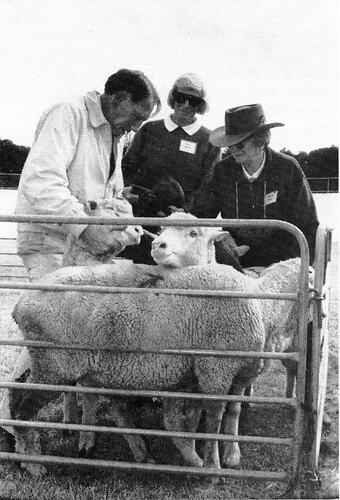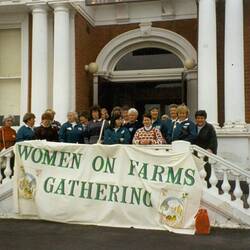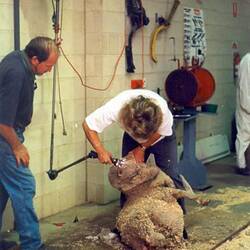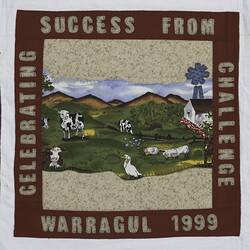Summary
Photograph taken at the 1996 Ararat Women on Farms Gathering. This image depicts two women receiving a lesson about sheep farming during a tour to Grampians Pure Sheep Dairy in Glenthompson.
Part of Museums Victoria's Invisible Farmer Project Collection. The Invisible Farmer Project was the largest ever study of Australian women on the land, uncovering the histories and stories of Australian women in agriculture. It began as a pilot project (2015-2016) and evolved into a three year (2017-2020) nation-wide partnership between rural communities, academic, government and cultural organisations, funded by the Australian Research Council.the absence of rural women in mainstream histories and museums.
Description of Content
Two women and a man stand in a fenced paddock with three sheep, on a property near Ararat. 'Responsive Sheepdogs' workshop at the 1996 Ararat Women on Farms Gathering. Lucy Richardson (Willaura) and Tim Austin (sheepdog trainer and kelpie stud owner, Elfindale Kelpies).
Physical Description
Black and White Digital Photograph
Significance
Tours have been a central feature of the Victorian Women on Farms Gatherings ever since the first tour, which was held at the 1991 Sea Lake Gathering. The purpose of tours is to give participants the opportunity to witness local farming practices and in doing so, to learn new skills and diversify their knowledge base. In the early 1990s the tours were mostly restricted to farm-based tours. However, as the Gatherings themselves evolved to include a range of broader rurally based activities and issues, tours too stated to become more diverse and include a range of non-farming educational opportunities. These tours are significant to the Victorian Women on Farms Gatherings, and also more generally in terms of their place in Australia's rural and social history. Situated in the wider context of the rural women's movement in Australia, these tours represent a collective move by rural women to educate themselves about farming enterprise, raise their public profile and in doing so, to challenge the dominant representation of rural Australia as a male domain.
More Information
-
Collection Names
-
Collecting Areas
Sustainable Futures, Home & Community, Working Life & Trades
-
Acquisition Information
Donation from Ms. Beryl Taylor, Dec 2006
-
Place & Date of Event
-
Place & Date Depicted
-
Format
Digital file, JPEG, Black & White
-
Classification
Agriculture & rural life, Community activity - women on farms gathering
-
Category
-
Discipline
-
Type of item
-
Keywords
Conferences, Dinners, Friendships, Rural Women, Rural Life, Rural Victoria, Agriculture, Women on Farms Gatherings, Community Groups, Farms, Farm Animals





